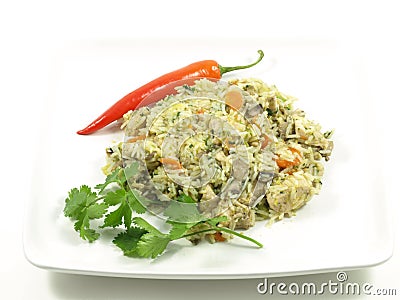
What is a healthy training diet? Regular and varied meals which are high in carbohydrate, relatively low in fat and well-balanced with protein, fibre, vitamins and minerals. There you have it; it’s not rocket-science. It is best to listen to you body – if you are training hard and you feel hungry, you probably need to eat something; training for something like a marathon burns a vast amount of calories! Average weekly mileages vary according to your training schedule, but training for a triathlon or a marathon can easily burn between 3000 and 5000 extra calories a week, even more for some.
I try to base my diet on about 60-70% carbohydrate – that’s cereal, potatoes, pasta, rice, fruit and vegetables -15% meat, fish and alternatives, about 10-15% milk and dairy foods and just a small percentage of foods containing fat and sugar
.

I made this sweet potato and chickpea couscous a few days ago. It's a nice high carbohydrate dish with a low glycaemic index that makes a fantastic alternative to pasta or rice. It's also quite light on the stomach so you can get a nice portion of carbs down you without feeling absolutely stuffed! We had this with a piece of grilled sea bream and it made for an absolutely delicious meal which only took a few minutes to prepare.
Sweet potato and chickpea couscous
250g couscous
a few sweet potatoes, peeled and chopped into small cubes
1 red pepper, halved and deseeded
1 tin of chickpeas, drained and rinsed
small bunch of flat-leaved parsley
squeeze of half a lemon
a few good glugs of extra virgin olive oil
salt and freshly ground black pepper
1 tsp ras-el-hanout
- Put the sweet potato and the red pepper on an oven tray, drizzle with olive oil and a few grinds of salt and black pepper and roast in a hot oven for about 20 minutes, until the sweet potato becomes soft and a little caramelised.
- Prepare the couscous - put the couscous in a bowl with a pinch of salt and a glug of olive oil. Pour over 300ml boiling water (check pack for exact amount). Stir and leave for 5 minutes (or time stated on the pack).
- Chop the parsley roughly and slice the red pepper.
- When the couscous is ready, fluff it up with a fork and then add the herbs, the chickpeas, the sweet potato, red pepper, ras-el-hanout, lemon juice and olive oil. Taste and add salt and pepper accordingly.
- Serve warm or cold with grilled fish or chicken, keep it in the fridge to snack on or take as part of your packed lunch.
 I can't believe I get through running shoes so quickly. I've just had to buy another pair as my current ones won't get me through the Stockholm Marathon without falling apart. I've just bought a gorgeous new pair of Brooks Infiniti from the lovely people at Up and Running. They really know what they are talking about there. In fact, the guy that served me guessed my 1/2 marathon time to within a minute, even before I had started running on their special fancy gait analysis treadmill. Aparently they are good for high mileage and have a lovely cushioned mid sole which seems to propel you forward...wonderful. I did 13 miles today and they felt good.
I can't believe I get through running shoes so quickly. I've just had to buy another pair as my current ones won't get me through the Stockholm Marathon without falling apart. I've just bought a gorgeous new pair of Brooks Infiniti from the lovely people at Up and Running. They really know what they are talking about there. In fact, the guy that served me guessed my 1/2 marathon time to within a minute, even before I had started running on their special fancy gait analysis treadmill. Aparently they are good for high mileage and have a lovely cushioned mid sole which seems to propel you forward...wonderful. I did 13 miles today and they felt good.




















 Stumble It!
Stumble It!
